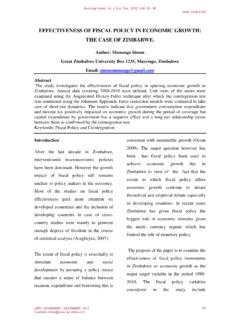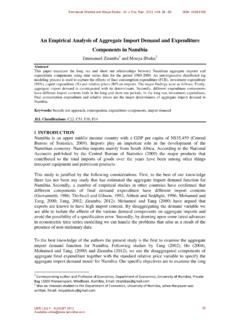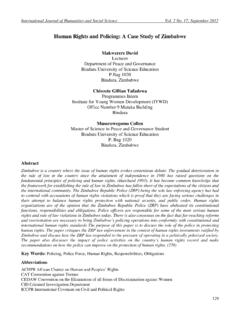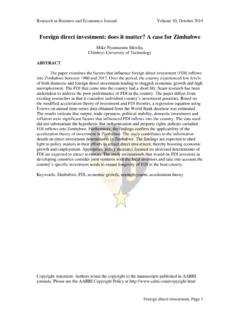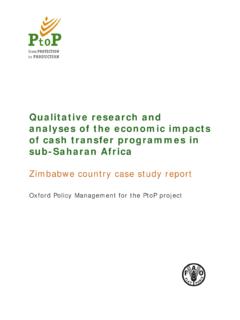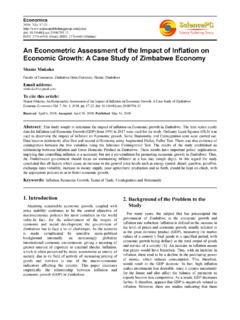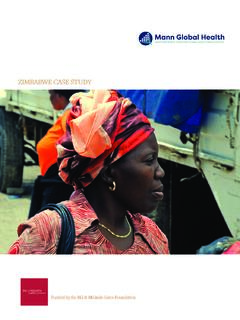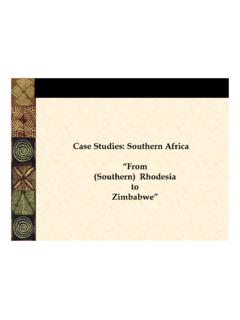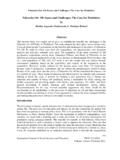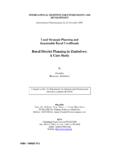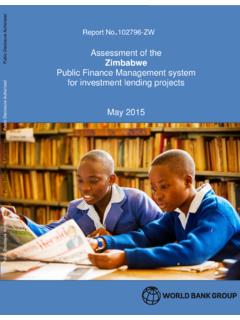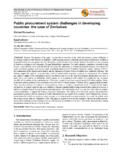Transcription of DETERMINANTS OF SMALL AND MEDIUM ENTERPRISES …
1 Mudavanhu,et, al.,Int. J. Eco. Res., 2011 2(5), 82 -89 ISSN: 2229-6158. DETERMINANTS OF SMALL AND MEDIUM ENTERPRISES FAILURE. IN zimbabwe : A case study OF BINDURA. Mudavanhu Victoria Bindu Samuel Chigusiwa Lloyd Muchabaiwa Lazarus Department of Economics Bindura University of Science Education 1020 Bindura zimbabwe Tel: 263-71-7531-6, 7621-4. Fax: 263-71-7534. Cell: +263 773 393 995, +263 773 973 585-6. Abstract The study seeks to establish the major causes of SMALL and MEDIUM ENTERPRISES (SMEs) failure in zimbabwe . Basing on a case study for Bindura, Ordinary Least Squares (OLS) estimation criteria was employed to estimate the change in return on investment function which was used as proxy for SME failure. Data were gathered through formal and informal interviews, questionnaires and focus group discussions with SMEs which were randomly selected from different clusters representing different industries.
2 Results showed that lack of general knowledge on business management, unavailability of credit, import competition and high cost of raw materials are the major causes of SME failure in zimbabwe . Key words: SMALL and MEDIUM ENTERPRISES , Informal Sectors, Economic growth JEL: E26, O17. 1. INTRODUCTION 85% of SMEs will eventually collapse. This The growth of SMALL to MEDIUM ENTERPRISES is a high statistic which is a major draw back (SMEs) is a critical ingredient in the to economic development and hence it is sustainable development of developing important to determine the major causes of economies. The history of economic SME failure so as to reduce the damage development tells us that promotion of caused by SME failure. infant industries is one of the major drivers behind the success of industrialization in SMALL to MEDIUM ENTERPRISES have taken a Europe (Rostow, 1960). Furthermore, centre stage in the social and economic improvement in SME productivity and size development of many nations (UNDP, is also cited as a crucial phase in the 2000).
3 In zimbabwe , SMEs in both formal successful implementation of export led and informal sectors have long acted as growth (ELG) strategy employed by East engines of economic growth. According to Asian countries which resulted in a Storey. and Westhead (1994.) SMEs are remarkable increase in economic growth in regarded as the seed-bed for the those countries (Singh, 1999). However, the development of large companies and are the growth and development of SMEs in life blood of commerce and industry at zimbabwe is generally undermined by a lot large. of challenges resulting in a high rate of failure of such businesses (SEDCO, 2004). In Countries like China and India, SMEs According to SEDCO (2004), about 60% of have led to economic expansion which in SMEs in zimbabwe fail in the first year of turn has resulted in employment creation, establishment, 25% fail within the first three poverty reduction, expansion of the years and the remaining 15% are likely to domestic market and widening of the tax survive.
4 This therefore implies that about base (Balassa, 1982). SMEs have also laid a IJER | SEPTEMBER - OCTOBER 2011 82. Available Mudavanhu,et, al.,Int. J. Eco. Res., 2011 2(5), 82 -89 ISSN: 2229-6158. strong foundation for the development of a Evidence from past studies competitive domestic private sector industry Past studies on SME failure show that lack as well as a self-sustaining market economy. of managerial experience is one of the main Furthermore, SMEs have the potential of reasons for SME failure. In a case study of increasing a country 's exports of Ghana, Inkoun (2003) found out that SMEs manufactured goods and reduce over performance is closely linked to dependency on the export of primary entrepreneurial skills of the proprietor. He commodities. It is against this background found out that proprietors with business that this study seeks to examine the major related qualifications tended to survive by causes of SMEs failure in zimbabwe .
5 30% more than non-qualified proprietors. Similarly, Ramis (2002) found out that Theoretical Literature although management training for The Production Theory as in Laidler (1972) proprietors is important for SMEs in Peru, it postulates that SMALL firms are inefficient is more important when the company has because they do not operate at the minimum higher growth potential than it is when the efficient scale where economies of scale are growth potential is low. He however, found enjoyed. This is because their average costs out that competition from both domestic and are always falling. The theory further asserts foreign firms is more predatory than that if firms do not find a way of increasing entrepreneurial skills. In his study , SMEs their scale so as to be able to enjoy faced with competition were three times economies of scale, they remain more prone to collapse than those without uncompetitive and hence have a high competition.
6 Likelihood of failing. Since SMEs generally do not enjoy economies of scale, the current In a study of SME failure in eleven African study also examines the extent to which countries using panel data, Pack (1993). failing to attain economies of scale can be a found out that in nine of them, the cost and cause of failure. availability of credit is a major factor that affects SME development as it stifles The Technological Capabilities Theory availability of funds for further investment. popularised by Lall (2001) argues that He also found out that import competition smallness is dangerous just like in the affects manufacturing and processing firms animal kingdom where younger and smaller more than it does to those that are in animals are easy prey for predators. The retailing. theory postulates that SMALL firms do not easily access funds from financial Furthermore, Koush (2008) in his study of institutions because they lack collateral and SME failure in Korea found out that foreign hence lending to them is viewed as highly competition is more predatory to SMEs that risky.
7 This means that the only plausible are in manufacturing than domestic way that SMEs can raise capital is through competition. This study split the competition self-financing, but since their initial capital variable into domestic competition and is SMALL and their sales value is also SMALL competition from imports in order to against very high operating costs, they are establish the relative strength of the different caught in a vicious circle of smallness which competition sources to the determination of is hard to break out of and may result in SME failure in different industries. eventual collapse of SMEs. IJER | SEPTEMBER - OCTOBER 2011 83. Available Mudavanhu,et, al.,Int. J. Eco. Res., 2011 2(5), 82 -89 ISSN: 2229-6158. 3. METHODOLOGY industry might not qualify in another The study adopted the model by Tian (2005) industry. Therefore taking absolute values of who proxied SME failure by the change in the quantitative variables will result in high Return On Investment (ROI).
8 The Ordinary variance leading to the problem of Least Squares (OLS) estimation method is heteroscedasticity, thus in the study we shall then used to estimate the change in ROI standardize variables by dividing through all function as in Chan (1996) quantitative variables by initial capital . More so, it is reasonable to assume that The Model import competition affects manufacturing Most empirical studies on failure of SMEs and processing firms more than it does on use the change in return on investment the other clusters. Equation 2 becomes: (ROI) to infer viability of SMEs. Persistent negative changes will result in eventual N .. = 0 + 0 ED + 1. CR. + 2. RM K. + 3 DC + 4 M + 5 + . collapse of the entity since they don't have a . solid financial base to continue shielding the (3). losses. Thus the study shall adopt the change For SMEs however, no major capital in ROI as a measure of SME failure.
9 Injection in the business are expected Following Tian (2005) the change in ROI especially in a short time period of say two function can be modeled as follows: years and hence K . It is also important to N . = f (ED, CR, RM , DC , M , K ) note that the cost of raw materials affect . firms in the secondary stage of production (1) (manufacturing, processing and construction) more than it does to firms in Where, is change the tertiary stage (retailing and transport). N is net profit for an entity This is so because cost of raw materials is initial capital constitutes a significant proportion of the N cost of production in the former clusters of is return on investment ROI. firms than it does in the latter. thus equation ED, is education level of the owner / 3 reduces to: proprietor N CR RM RM. = ( 0 + 5 ) + 0 ED + 1 + 2 + 3 DC + 4 M + 6 D+ . CR is the amount of credit extended . RM is cost of raw material (4).
10 DC is domestic competition RM. Where, D shows the interaction M is foreign competition/imports . K is capital stock between cost of raw materials and being in Thus equation 1 can be expressed as: either secondary stage of production or in N tertiary stage of production. = 0 + 0 ED + 1CR + 2 RM + 3 DC + 4 M + 5 K + . Equation 4 can be rewritten in compact form (2) as equation 5 which we are going to Where is the stochastic error term, estimate. representing the influence of all the other = + 0 D1 + 1 + 2 + 3 D2 + 4 D3 + 6 D4 + . variables (5). However, heterogeneous SMEs in different CR RM. Where = and =. industries have different sizes such that a . firm that might qualify as an SME in one ED, DC , and M are qualitative variables IJER | SEPTEMBER - OCTOBER 2011 84. Available Mudavanhu,et, al.,Int. J. Eco. Res., 2011 2(5), 82 -89 ISSN: 2229-6158. and we shall use dummy variables D1 , D2 , Availability of credit ensures smooth operation of SMEs as it injects working and D3 respectively to capture them.

